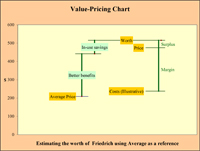Tools for Market-Value Pricing The Value-Strategy Toolkit™ Customer Value, Inc.'s software has the tools you need to evaluate the performance of your products relative to competitors and estimate a fair price for them. You start by developing a Market Profile table, a scorecard that compares the competing products in terms of their performance on a list of product attributes. (For example, for an automobile, attributes might include ride comfort, gas mileage, acceleration, etc.) Also in the table are weights indicating the relative importance of the attributes to the customer. The table also includes the current prices for the products. That's it! With this small set of data, you can generate all of the analyses you need for Market-Value pricing. The Value Map links performance and price
The Value Map is a key tool in customer value analysis used for Market-Value pricing. When you complete a Market Profile table, the software develops a weighted average measure of overall performance for each competitor. The value map plots price against this measure of overall performance. It enables you to see if your product is priced in line with its overall performance strengths and weaknesses. The sloping fair-value line shows the fair price for any given performance level. It provides a hard benchmark for pricing your product in line with the benifits you offer. The Value Pricing Chart summarizes the major considerations in setting your price
To appraise a product, the software starts with a reference product -- the standard against which your product will be evaluated. Typically the reference product is a statistical average of all of the products in your product category, although it could be one of the actual competitors. The reference product has a price and a set of performance measurements. The appraisal starts with the reference-product price as a baseline. It adds to this the worth of your performance advantages, net of the worth of your performance disadvantages, relative to the refrence product. Then a final adjustment is made for any known differences in the costs of owning or using the product. The end result is an appraisal of the worth of your product. After looking at the appraisal, you still have to decide how to price your product. It is important, of course, to charge more for your product than it cost you to make it. (Otherwise, you have negative profits.) Most analysts like to charge somewhat less than the product is worth, giving the customers a good deal. So, the final pricing decision often amounts to picking a price point above the product's cost and below its worth, leaving room for profits and giving the customer some surplus. All of these steps are shown graphically in the value-pricing chart. |


